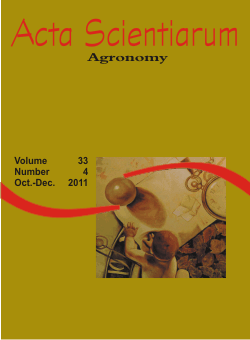<b>Micropropagation of an <em>Eucalyptus</em> hybrid (<em>Eucalyptus benthamii x Eucalyptus dunnii</em>)</b> - doi: 10.4025/actasciagron.v33i4.8317
Keywords:
in vitro establishment, culture medium, cloning, BAP, NAA, GA3
Abstract
This study was designed to micropropagate E. benthamii x E. dunnii, by testing chlorine concentrations for explant asepsis, the optimal concentrations of benzylaminopurine (BAP) and naphthaleneacetic acid (NAA) for bud proliferation, and the ratio between BAP and gibberellic acid (GA3) in two nutrient media for shoot elongation. Nodal segments from H12, H19 and H20 clones were disinfected with 0.5, 1.0, 1.5 and 2.0% (v v-1) of chlorine. Explants were grown on ½MS medium supplemented with BAP (0, 0.25, 0.50, 0.75 and 1.00 mg L-1) and NAA (0, 0.025, 0.050, 0.075 and 0.100 mg L-1) for bud production. They were elongated on MS and ½MS media supplemented with BAP (0, 0.05 and 0.10 mg L-1) and GA3 (0, 0.1, 0.2 and 0.3 mg L-1). The 0.50 mg L-1 BAP and 0.050 mg L-1 NAA combination was optimal for bud proliferation for H12 and H20. GA3 concentrations of 0.10 and 0.2-1 mg L-1 combined with 0.10 mg L-1 BAP on ½MS resulted in the longest shoots, for H12 and H20, respectively. Regardless of clone, the rooting rate was low, with an average of 12.0% and 14.4% of plants having roots for in vitro and ex vitro conditions, respectively.Downloads
Download data is not yet available.
Published
2011-05-04
How to Cite
Brondani, G. E., Dutra, L. F., Wendling, I., Grossi, F., Hansel, F. A., & Araujo, M. A. (2011). <b>Micropropagation of an <em>Eucalyptus</em> hybrid (<em>Eucalyptus benthamii x Eucalyptus dunnii</em>)</b> - doi: 10.4025/actasciagron.v33i4.8317. Acta Scientiarum. Agronomy, 33(4), 655-663. https://doi.org/10.4025/actasciagron.v33i4.8317
Issue
Section
Crop Production
DECLARATION OF ORIGINALITY AND COPYRIGHTS
I Declare that current article is original and has not been submitted for publication, in part or in whole, to any other national or international journal.
The copyrights belong exclusively to the authors. Published content is licensed under Creative Commons Attribution 4.0 (CC BY 4.0) guidelines, which allows sharing (copy and distribution of the material in any medium or format) and adaptation (remix, transform, and build upon the material) for any purpose, even commercially, under the terms of attribution.
2.0
2019CiteScore
60th percentile
Powered by 

2.0
2019CiteScore
60th percentile
Powered by 



















































